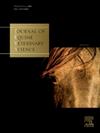Evaluation of spectral entropy monitor with different concentrations of isoflurane in Horses
IF 1.3
3区 农林科学
Q2 VETERINARY SCIENCES
引用次数: 0
Abstract
Spectral entropy and bispectral index (BIS) can differentiate between conscious and unconscious levels in horses. This study aimed to determine whether spectral entropy and BIS parameters can distinguish between different end-tidal isoflurane concentrations (EtIso, %), and whether these parameters change when a nociceptive stimulus is applied. Ten clinically healthy horses were anaesthetized using xylazine, diazepam, ketamine, and isoflurane. The following parameters were monitored: EtIso, response entropy (RE), state entropy (SE), RE-SE difference, BIS, and electromyography (EMG). Three EtIso concentrations were randomly assigned: 0.9 % (EtIso0.9), 1.2 % (EtIso1.2), and 1.5 % (EtIso1.5). Ten minutes after reaching the first EtIso, the parameters were recorded at baseline (Baseline) and for 5 min following the application of an electrically nociceptive stimulus (first two minutes, EarlyP; the last three minutes, LateP). This procedure was repeated three times for each EtIso. A two-way repeated measures ANOVA was performed. The RE, SE, BIS, and EMG parameters exhibited a significant increase upon the application of a painful stimulus. Notably, only the EMG parameter demonstrated significant differences between EtIso0.9 and EtIs1.5 during both EarlyP and LateP phases (EarlyP: EtIso0.9, 72 ± 23 vs EtIso1.5, 48 ± 23, (P = 0.011); LateP: EtIso0.9, 65 ± 27 vs EtIso1.5, 43 ± 23, (P = 0.022)). Currently, these monitors do not appear to be useful for assessing anaesthetic depth in horses under the studied conditions, although they do seem to be useful for detecting induced nociceptive stimuli.
求助全文
约1分钟内获得全文
求助全文
来源期刊

Journal of Equine Veterinary Science
农林科学-兽医学
CiteScore
2.70
自引率
7.70%
发文量
249
审稿时长
77 days
期刊介绍:
Journal of Equine Veterinary Science (JEVS) is an international publication designed for the practicing equine veterinarian, equine researcher, and other equine health care specialist. Published monthly, each issue of JEVS includes original research, reviews, case reports, short communications, and clinical techniques from leaders in the equine veterinary field, covering such topics as laminitis, reproduction, infectious disease, parasitology, behavior, podology, internal medicine, surgery and nutrition.
 求助内容:
求助内容: 应助结果提醒方式:
应助结果提醒方式:


